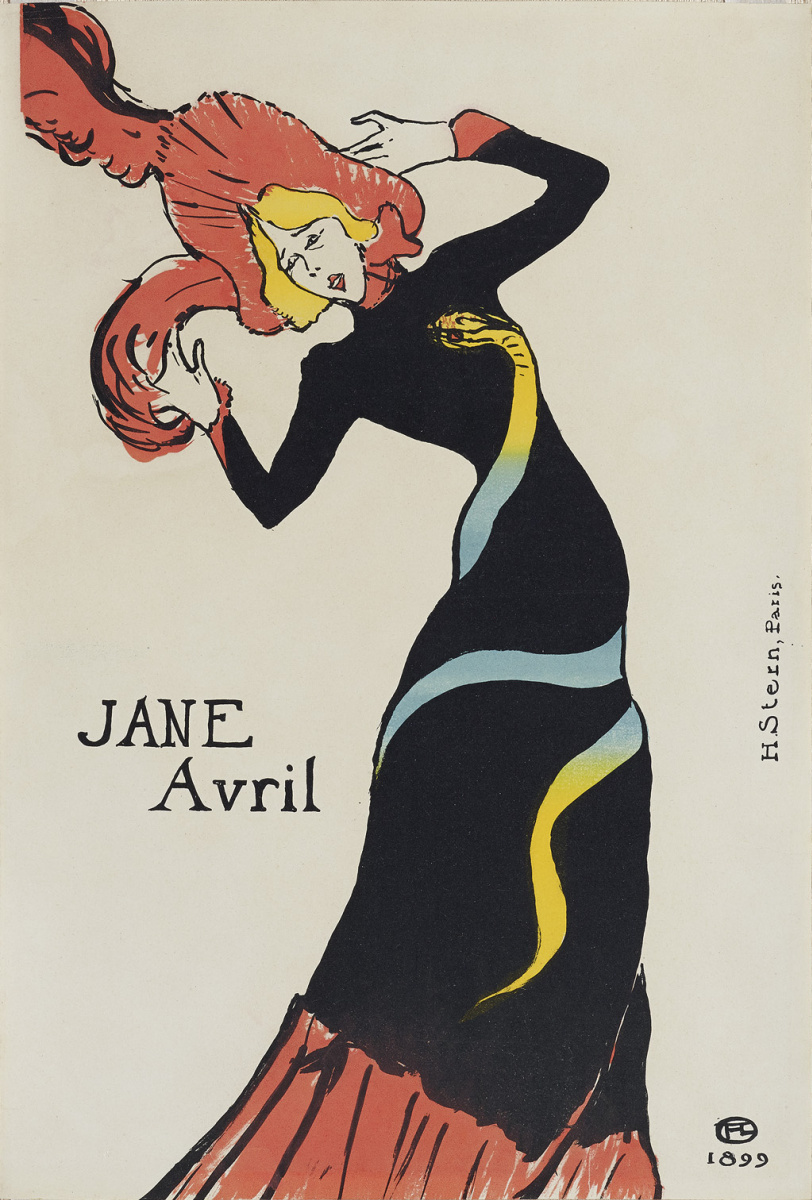log in
Enter site
Login to use Arthive functionality to the maximum
Jane Avril
Henri de Toulouse-Lautrec • Painting, 1899, 55.5×37.9 cm
Description of the artwork «Jane Avril»
Many of Toulouse-Lautrec's posters were commissioned by his artist friends. The cancan dancer Jane Avril turned to the artist to advertise her shows twice: first time - in 1893, and another six years later, in 1899. In each case, he created a "brand" of the artist, emphasizing her recognizable features - a slender, airy figure and bright red hair.
Although both of these posters accurately reflect Avrille's image, the difference in design can probably be explained by the six-year gap between them. In 1893 she was a relatively new face on the stage, and so Lautrec deliberately depicted her as a dancer performing a fashionable cancan. His novelist frame idea played with concepts of space and perspective influenced by the flat compositions of Japanese prints. But by 1899, Jane Avril's name had become a household name. She was so well known to the public that Lautrec limited himself to an elegant silhouette of her friend with a reference to the incoming Art Nouveau style.
Raising her hands in mock surrender, the dancer seems to surrender to the snake that encircles her black dress. Jane's body may appear to be curved too unnaturally, but that may also have been her singularity. From the recollections of the poet Arthur Simons: "She was so thin and flexible that she could bend backward until her shoulders touched the floor.".
This poster has its own - sad - backstory. on January 4, 1899, Lautrec's mother suddenly left Paris, and this provoked a nervous breakdown in her son. She - unlike his father - was more or less constantly present in his life, and the parting knocked him out. The artist wrote to his family: "My cousin Gabriel took care of me day and night during the nervous breakdown caused by my mother's unexpected departure. I ask my family to give him a splendid memorial gift.".
During the first weeks of the Countess's absence, her maid, Bertha Sarrazin, kept a daily diary describing Toulouse-Lautrec's anger, suffering, fear, amnesia, and drunkenness.
By March 17, the artist, who had been admitted to Dr. Semelin's sanatorium on the Avenue de Madrid, felt sufficiently recovered. He wrote to the gallerist Maurice Joyein requesting that he give him materials for a flat print: "Send me some grit stones and a box of watercolors with brushes, litho crayons, and high quality Indian ink and paper.". A month later, Lautrec was allowed to leave the hospital, and then his faithful friend Jane Avril commissioned him to create what became the last poster on her order.
In this final offering to the dancer, Lautrec expressed the very essence of Avril, her snake-like dance, the elaborate headdress that extends beyond the composition, and the yellow and blue appliqué of the snake on her black dress.
Unfortunately, this poster with Jane Avril was one of the last two posters of the artist's career. His failing health prevented him from returning to this important field of his work, in which he had reached considerable heights.
Author: Vlad Maslov
Although both of these posters accurately reflect Avrille's image, the difference in design can probably be explained by the six-year gap between them. In 1893 she was a relatively new face on the stage, and so Lautrec deliberately depicted her as a dancer performing a fashionable cancan. His novelist frame idea played with concepts of space and perspective influenced by the flat compositions of Japanese prints. But by 1899, Jane Avril's name had become a household name. She was so well known to the public that Lautrec limited himself to an elegant silhouette of her friend with a reference to the incoming Art Nouveau style.
Raising her hands in mock surrender, the dancer seems to surrender to the snake that encircles her black dress. Jane's body may appear to be curved too unnaturally, but that may also have been her singularity. From the recollections of the poet Arthur Simons: "She was so thin and flexible that she could bend backward until her shoulders touched the floor.".
This poster has its own - sad - backstory. on January 4, 1899, Lautrec's mother suddenly left Paris, and this provoked a nervous breakdown in her son. She - unlike his father - was more or less constantly present in his life, and the parting knocked him out. The artist wrote to his family: "My cousin Gabriel took care of me day and night during the nervous breakdown caused by my mother's unexpected departure. I ask my family to give him a splendid memorial gift.".
During the first weeks of the Countess's absence, her maid, Bertha Sarrazin, kept a daily diary describing Toulouse-Lautrec's anger, suffering, fear, amnesia, and drunkenness.
By March 17, the artist, who had been admitted to Dr. Semelin's sanatorium on the Avenue de Madrid, felt sufficiently recovered. He wrote to the gallerist Maurice Joyein requesting that he give him materials for a flat print: "Send me some grit stones and a box of watercolors with brushes, litho crayons, and high quality Indian ink and paper.". A month later, Lautrec was allowed to leave the hospital, and then his faithful friend Jane Avril commissioned him to create what became the last poster on her order.
In this final offering to the dancer, Lautrec expressed the very essence of Avril, her snake-like dance, the elaborate headdress that extends beyond the composition, and the yellow and blue appliqué of the snake on her black dress.
Unfortunately, this poster with Jane Avril was one of the last two posters of the artist's career. His failing health prevented him from returning to this important field of his work, in which he had reached considerable heights.
Author: Vlad Maslov


